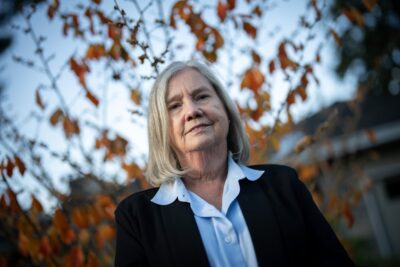These doctors helped eliminate measles in ’98. Here’s how they did it
By Canadian Press on October 29, 2025.

TORONTO — Dr. Arlene King got measles more than 60 years ago, but she still remembers feeling so weak that getting her shoes on was a challenge.
It didn’t take long for King, who was in Grade 1 at the time, to infect her 18-month-old brother whose fever spiked to such a high temperature that it triggered his body to convulse in a febrile seizure.
“It really was not a benign disease,” said King, who went on to become a leading public health specialist involved in measles prevention at federal and provincial levels.
Measles was ubiquitous before there was a vaccine to prevent it and King remembers her mother’s gratitude and eagerness to get her uninfected kids immunized when a vaccine was approved in 1963.
Parents and public health providers rallied to stop the circulation of one of the most contagious diseases in the world, ultimately resulting in the elimination of measles in Canada in 1998.
But now the country is poised to lose that status.
Transmission of the disease has been ongoing for a year, since an outbreak began in New Brunswick in October 2024 and spread to other provinces, infecting more than 5,000 people in Canada.
Physicians who were instrumental in achieving Canada’s measles elimination status say they are disheartened by this disruption to a hard-fought public health achievement that lasted more than 25 years, but some are hopeful that it could also push the country to come together to get it back.
A SERIOUS ILLNESS
An average of 45,000 measles cases spread annually from 1924 to 1958, according to a Public Health Agency of Canada report. Outbreaks would wreak havoc every two to three years, causing schools to close and children to fall ill, many with severe complications, such as inflammation of the brain, pneumonia, deafness and death.
Dr. James Talbot, Alberta’s former chief medical officer of health, grew up on an air force base in a small town on the province’s northeast border in the early 1960s. For him, a telling detail of the time was the establishment of school programs specifically for the significant number of children who lost their hearing due to measles complications.
He said the “game changer” was the first measles vaccine in Canada, which was a single dose. Cases dropped to an average of 9,863 annually between 1969 and 1983, and intervals between outbreaks stretched to every five to six years.
Not long after Dr. Gaston De Serres started practising family medicine in Quebec, an outbreak of 10,000 cases seized the province in 1989. De Serres began researching the measles vaccine to understand why it wasn’t preventing such outbreaks from happening, despite immunization coverage of 99 per cent in some Quebec City schools.
De Serres’ research, which built on a body of international evidence, found some children did not respond to the first dose, but when they received a second dose, they were protected.
That’s because of primary and secondary failure, De Serres said.
Primary failure is when a person is vaccinated, but they don’t receive immunity from the vaccine, and are left unprotected. Secondary failure is when you are initially protected, but it wanes over time.
“If we want to eliminate measles, we have to go to a two-dose program where those children who did not respond to the first dose would then receive the second dose and be protected,” said De Serres, who retired a few years ago as a medical epidemiologist at the Quebec Institute of Public Health.
Despite the evidence, Canada did not immediately adopt a two-dose strategy.
CATCH-UP CAMPAIGNS
In 1994, Canada’s health minister signed on to the goal of eliminating measles from the Americas by 2000, alongside leaders from other countries at a Pan-American Health Organization (PAHO) conference, the World Health Organization’s regional arm for countries in North and South America.
The following year Canada’s case count exceeded 2,100, representing over 50 per cent of cases reported in the Western Hemisphere.
A National Advisory Committee on Immunization (NACI) document published in 1996 described the country’s approach several years earlier as “laissez faire” as its one-dose policy persisted while other countries in the Americas had already implemented routine two-dose programs, including the United States in 1989.
NACI recommended an organized two-dose program and mass catch-up campaign across the country.
In 1996, those rolled out across provinces. Public health nurses vaccinated entire schools at a time, often in the gym, Dr. Monika Naus recalls from the early days of her career as medical lead of Ontario’s measles elimination program.
In just six weeks public health officials vaccinated four million children from kindergarten to Grade 13 in the province.
“I would say it was probably my proudest achievement in my entire career because there was a very palpable difference in what was happening with measles before and after that program,” said Naus, who later served as chair of NACI and medical director of vaccine preventable diseases at the BC Centre for Disease Control.
There was also a positive feeling that came from the country working together to push forward towards a shared goal, she recalled.
Two years later, Canada achieved its elimination status.
WHAT’S NEXT?
Growing up on an air force base, Talbot said people often spoke about the endurance of war.
“It’s long periods of boredom interspersed with periods of intense activity and that’s the way it was from 1981 on,” he said, drawing a parallel with measles.
“You had to stay sharp, you had to be alert, you had to be prepared to move quickly and get the resources immediately to where they needed to be. But if you did all of those things, you could ensure that that was the end of the outbreak.”
For many years that pattern persisted, but Talbot worries we lost sight of the unified approach that once herded us toward the elimination status now slipping through our fingers.
However, he does see a way forward.
“If there’s a recognition that this is a terrible thing, reputationally, and more importantly, for what it says about how well our system is working, and that it requires an expert evidence-driven plan to fix, and that there’s a political commitment to making that plan operational over five, 10, 15 years, whatever it takes, then we have a much brighter future for our children.”
This report by The Canadian Press was first published Oct. 29, 2025.
Canadian Press health coverage receives support through a partnership with the Canadian Medical Association. CP is solely responsible for this content.
Hannah Alberga, The Canadian Press
41-40

